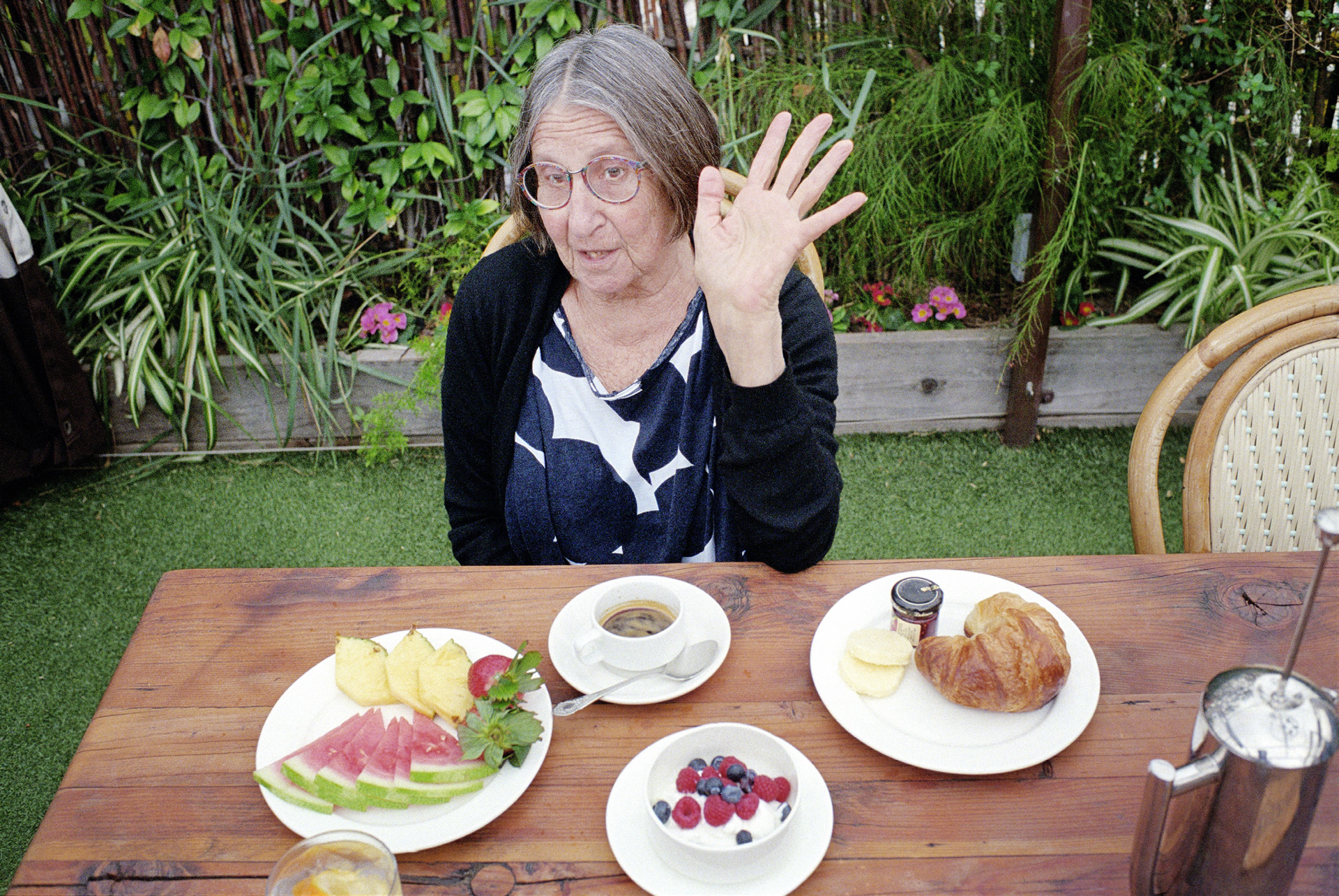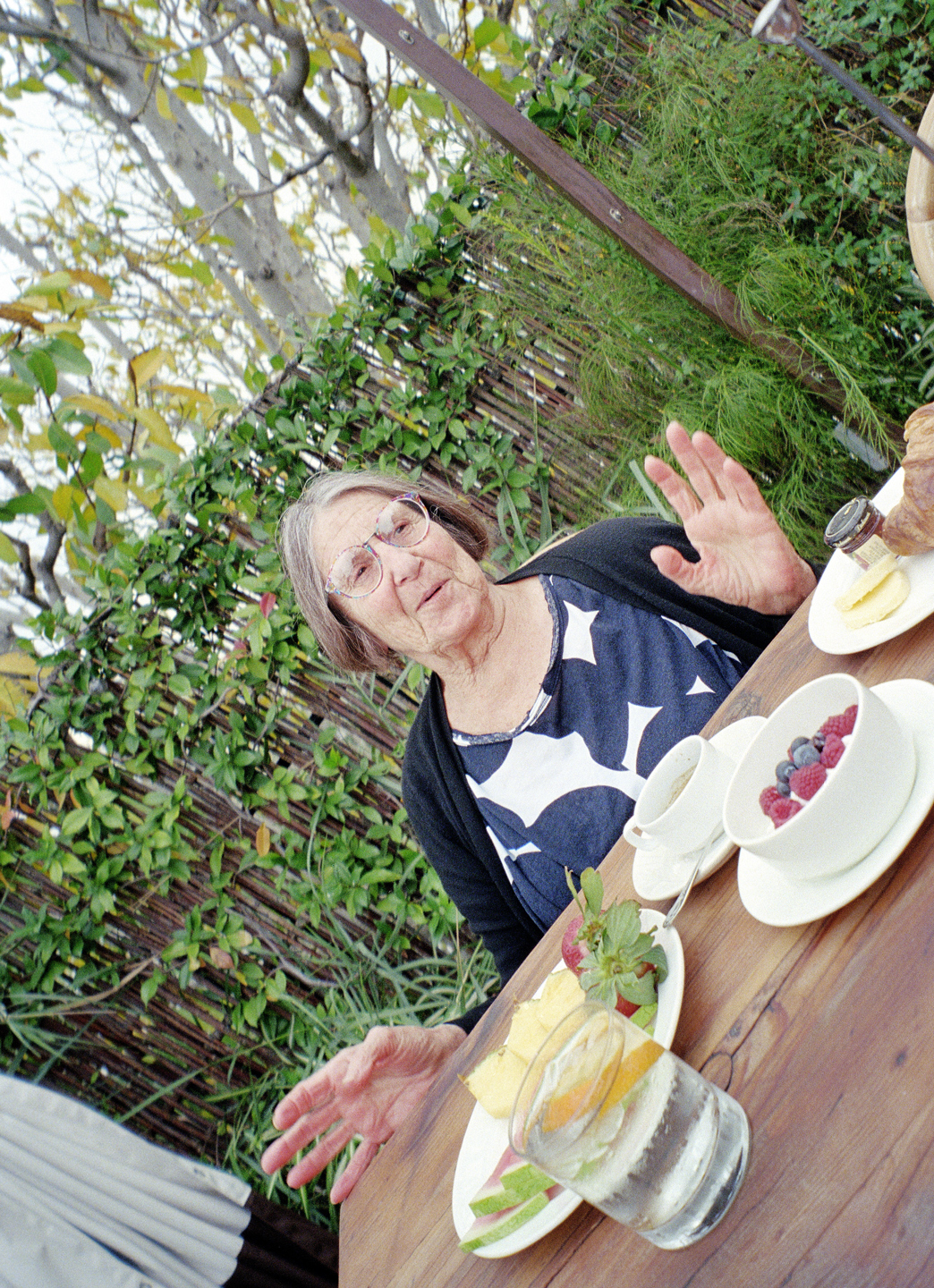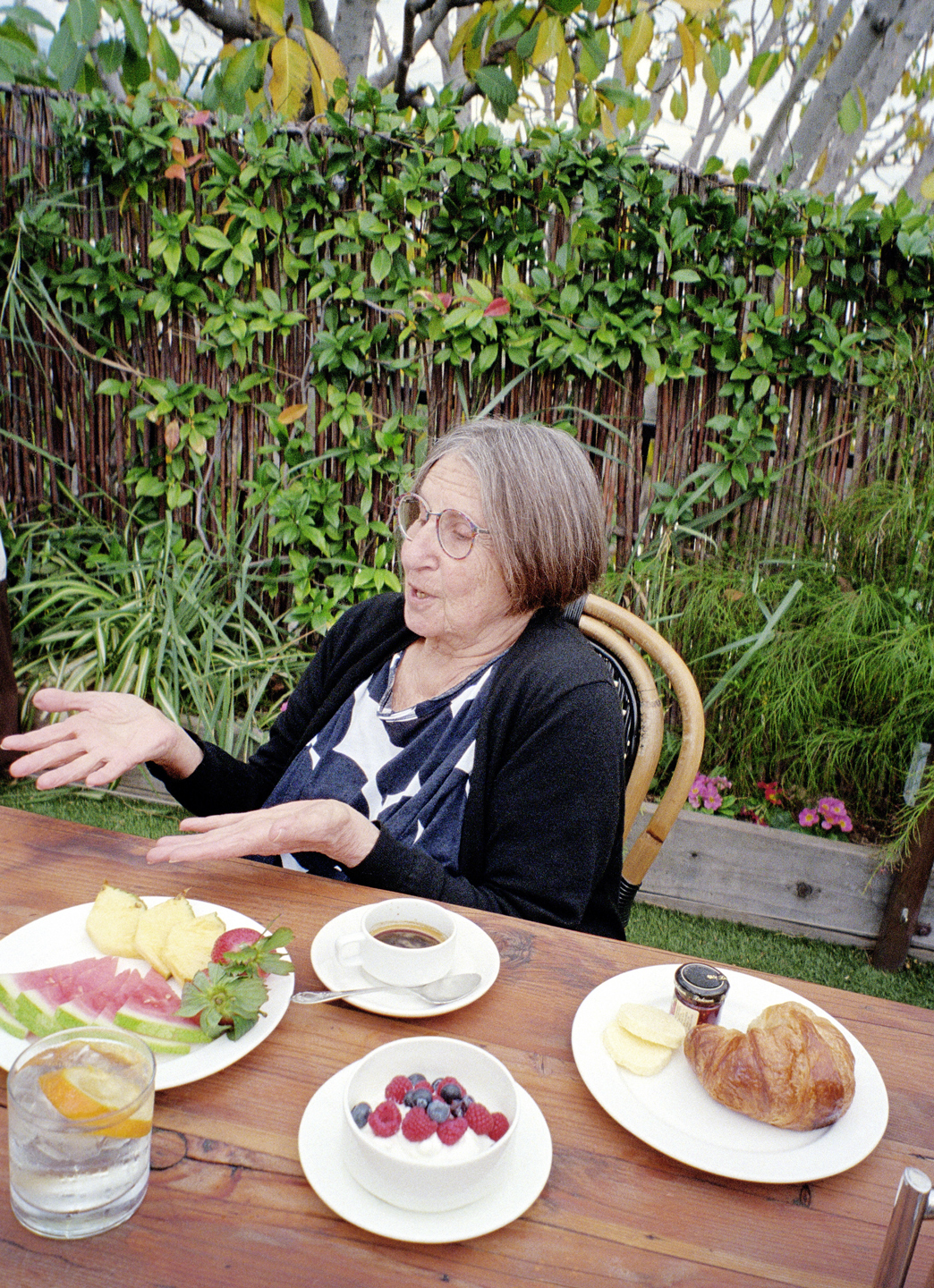Breakfast with Betty Woodman
At Petit Hermitage’s Private Rooftop West Hollywood
Conversation with Nicola Ricciardi Photography Stefano Galli

-
NRLet’s start with your latest endeavour; can you tell me more about the show at David Kordansky’s Gallery?
-
BWThe show has a title – and I think somehow that’s what it is all about: it’s called “Illusions of Domesticity”. It’s a show that plays with perspective and is primarily made of pieces that I would call paintings; painted canvas with ceramic elements melted on them. Each of these so-called paintings is a domestic scene; there’s often a table, which is painted, and all the objects that one might find on a table mounted on it.
-
NRWhat was your inspiration for the series?
-
BWIt actually came from a visit to a museum of roman sculpture. It wasin a palazzo, and there was a series of beautiful wall paintings, including one depicting a wedding breakfast with an illustration of all the dishes used. I remember a piattaia up the wall with stacks of plates and food baskets. I think that’s where the inspiration for this particular series came from.
-
NRI’d say that some dynamic aspects of ‘conviviality’ have often emerged in your work. This is all the more evident when discussing a wedding breakfast – and with the two of us having breakfast here.
-
BWYes, that is actually what I was about to say! Even if it’s not a real breakfast in the piece, but an illusion, I think it relates very much to, say, Pierre Bonnard, his paintings were all about ‘domesticity’, am I right?
-
NRIndeed. And it is interesting that you mentioned Bonnard; I think there’s always been a continuous back and forth between pottery and painting in your practice, but your recent works seem to be a little more inclined towards the latter rather than the former. Do you think you’re moving more straightforwardly towards painting, that you’re taking a conscious step in that direction?
-
BWWell, I don’t think my work evolved in any kind of self-conscious way. When I started working I was interested in being a functional potter, also in terms of idealistically serving society. I think that what we use and what we handle affects the way we live: the cup you drink from... can change your life! Now, I think that as my work has evolved I became less fixated with function. But there was never any decision, no moment when I said “I want to become a painter”.
-
NRAre you saying that it somehow happened, as a natural process?
-
BWI really wanted to make good use of the experience that I had as a potter and not sort of end with pottery to start something else. I met a lot of artists that, say, started off with clay and then consciously decided: “I am a sculptor now!” For me, it was a matter of seeing how I could possibly transform my skills into something else that was challenging and that was exciting to do. At first, I didn’t know what the answer was. But for me, as an artist, what’s important it is not necessarily the piece I made yesterday, it’s the piece I’m going to make tomorrow. If you know everything already, there’s no point in doing anything!
-
NRWhen you mentioned the “functional” aspects of your work, you made me think of something that I believe is connected to your practise in general: ethics – the ethics of taking art seriously, taking it as a job, as something that makes you go to the studio every day.
-
BWThat’s right. I am very interested in the work ethic of ‘putting in your hours’. Probably, it has to do with my age and with being American. You know, in the Seventies, that was what you were supposed to do as an artist: you put in your hours everyday. This is no longer true. At the time, it was the right thing to do, and both George and I worked almost obsessively. Now it’s very different. Nonetheless, I believe that different artists work differently, and I don’t think that the way you work makes you a better or worse artist. But putting in the hours was – and still is – intrinsic to my practice. For instance, I never wait to have a show to do the work!
-
NRStill – and correct me if I’m wrong – many of your shows have a site-specific aspect to them.
-
BWI certainly do installations that are site-specific. And let me tell you, it’s a lot of fun too! But I am not interested in waiting until somebody asks me to do something – I just can’t work that way and I am more comfortable with just working anyway and then perhaps picking what I hope are the best pieces for the show, the ones that seem to make sense together within the space. Actually, what is fascinating for me is that each exhibition space I’ve worked with lately has been pretty different from the next; so the shows have looked very different too. Take this latest one at David Kordansky’s, George (Woodman, Betty’s husband) says it’s the most beautiful show I’ve ever done.

-
NRAnd, as a matter of fact, it is quite different from the 2013 show at Isabella Bortolozzi in Berlin…
-
BWOh, that was a wonderful experience too! But it was very specific: that space was a kind of apartment, so it was very domestic in itself. As I said before, I have a particular interest in ‘domesticity’, but also in playing with physical spaces the way the Romans played with their painted rooms: where you have a room which is essentially nothing and then you create it by painting on the walls. Roman frescoes have been an incredible source of inspiration to me.
-
NRIt is interesting to see how your work combines a very Italian aesthetic – like that of the Roman frescoes – with what you’ve called an ‘American’ work ethic. This link between Italy and the United States is something that I also personally relate to: my family comes from Tuscany – from Panzano actually, a 10 minute drive from Antella, where your house is – but I’ve lived in New York City for quite some time now, and there are aspects of one country that I fully understand only when I spend time in the other, and vice versa.
-
BWI know exactly what you mean! It’s fascinating: there is nothing like living in a foreign country to make you realize how American you are. People think that I’m not your typical American since I’m an artist, yet, the longer I live in Italy the more I realize my reaction to it. For 20 years we spent four months of the year teaching in Colorado, then 4 months in New York and 4 months in Italy. Three extremely different settings. At first, it took us a long time to slow down between New York and Italy. It’s been over 45 years since we bought the house in Antella; I think we are probably some kind of hybrid by now. But I think it’s also like being schizophrenic.
-
NRWhere do you feel more at home – in Antella or in New York City?
-
BWIn New York we live on the fourth floor of a loft and we love it! But it’s not like the love we have for Italy. I think that for me it also has to do with what I am as an artist. I went to Italy for the first time when I was 20 years old: I lived in Fiesole, near Florence. There was a potter’s studio behind a house near the roman theatre in town. I remember knocking at this door, with an American friend of mine, and asking: “can we work here with you?”. I worked for those guys for a year and it was an amazing experience because I was fresh out of school and I knew all the rules of ‘doing ceramics’ which they had no idea they existed! They were making wonderful things by essentially breaking all the rules. The first lesson I learned there was that the rules are just meant to be broken.
-
NRWhat else did you learn from your time in Italy?
-
BWIn Italy I became aware of a whole other world of ceramics – one that was a marriage of painting and form. I was totally blown away by Etruscan pots, for example. But to live in Italy you also have to learn how to live at a different pace. The way you eat, the fact that we eat food that is growing in our garden: our life it’s very different when we are in Antella.
-
NRI know! Food is a serious matter in Tuscany. When I am in Panzano, I choose the meat I eat very carefully. I only go to one butcher now, Mr. Checcucci, after a ‘selection process’ that took years. Do you have a favourite macellaio too?
-
BWYes! We go to a wonderful butcher in Grassina, not far from Antella. It’s a bit expensive, but outstanding. We often do groceries in Grassina too. They have a really good fruttivendolo there, and the bread is marvellous.
-
NRAnd where do you buy your cheese and wine?
-
BWI buy the cheese at the mercato in Antella. It’s the same man that comes to Panzano on Sunday mornings.
-
NROh, I know him!
-
BWHe has very good cheeses, such as buccia di rospo. The butcher in Grassina has it for 45 euro/kilo and this other one sells it for 25! That’s the difference.

-
NRYou seem to take food pretty seriously, just as a local would do…
-
BWI think it has to do with my father working in a supermarket for all his life. He probably started off sweeping the floors during the depression. He had to leave college because there was no money at the time, and he got a job as soon as they had my sister. He soon became the vegetable man, then the buyer and then worked his way up to became executive. I clearly remember growing up with him going to the market in Boston everyday. Therefore, in my house, what you ate was very important.
-
NRIn my house as well. We always had a sort of religious response to food. Was it like that for your husband too?
-
BWOn the contrary. For George’s family, to be preoccupied with food was really bad taste: you just shouldn’t be concerned about it. For me it was so different: my mother worked and my sister wasn’t so interested in food, so I grew up cooking. It was my business to make dinner. I think the relationship between something like pottery and cooking is a very important one. I think that if you want to be a good potter you need to…
-
NR…learn how to cook!
-
BWExactly: learn how these things are made. If you make a teapot and a cup and then you make tea... well, you don’t want to cut your finger when you lift the cup! There’s a relationship between these things. If you make a casserole pot and you also know how to make a stew, it works better.
-
NRJust like in order to appreciate eating you have to appreciate cooking. If you know how the dish is made, the process, the ingredients… then what you are eating is not just food, it is a method, a tradition, history.
-
BWYes, I totally agree. It is important which rice you use for which dish – the rice thing is fascinating actually, I think. Back in the days, Americans didn’t know there were different kinds of rice: there was rice and that was it. People used to get furious with me. For example, I learnt to make my own pasta; we had a sort of maid, a bambinaia from Emilia Romagna: she taught me how to do la sfoglia. When I went back to Colorado, the American flour didn’t work. I went to all the stores there and also in New York, and they just laughed at me! Now it has all changed.
-
NRNow I think it’s quite the opposite, at least in New York. There are probably too many options…
-
BWI agree. We are living in an age where food is the new religion. I keep hearing people saying “I’m only going to drink soymilk,” or almond milk, and I said to a friend of mine just yesterday “what’s the matter with regular cow’s milk!”
-
NRYes, I remember the first time I moved to the United States. I spent a solid 10 minutes in front of the milk aisle, just looking for regular milk.
-
BWI know: sometimes I just want milk!

-
NRI have just one last question: you still have to tell me where you buy your wine.
-
BWOh, I don’t drink: I’m astemia!
-
NRWell, it must be hard to live in Tuscany and be teetotal.
-
BWI know! It’s terrible. But George buys wine. When we bought our farmhouse we used to live in a very tight little community and we were physically attached to two large farm families. So we started off buying wine from them, but it was really bad! Then we would go across the valley to a villa near us, talked to the fattore to buy vino sfuso, and bottle it ourselves. But George didn’t want to drink the same wine all the time: so now we go to Esselunga [an Italian retail store chain].
-
Laughter
-
BWYou know, 45 years ago you couldn’t get any wine in Tuscany that wasn’t Tuscan. But there are lots of other wines in Italy that George wanted to try, and Esselunga was the first store to have a decent selection: they had Sicilian wines, bottles from Alto Adige, you know.
-
NROh, you have to tell George to try the wines from Valtellina too; it’s all I’m drinking at the moment. As soon as we’re both in Italy I’ll send him box of Grumello.
-
BWOh, thank you very much!
-
NRWell, thank you! Thanks for the time you have dedicated to me and for the lovely chat. Even if it made me a bit hungry, to be honest.
-
As I turned the voice recorder off, Mrs Woodman smiled and handed me the fruit platter. “Have a California strawberry,” she said in a charming Italian with just a hint of accent, “they are delicious”.